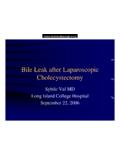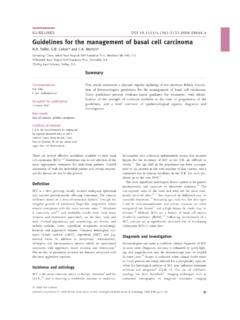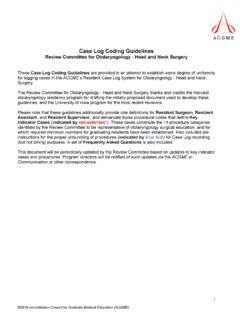Transcription of Skin adnexal neoplasm - SUNY Downstate Medical …
1 skin adnexal neoplasm Volodymyr Labinskyy, MD SUNY Downstate 12/05/2013 47 M c/o growing mass on the left cheek for the past 8 years PMH: none PSH: none Allergies: NKDA Home meds: denies Family Hx: non significant Biopsy was performed 2 weeks prior to hospitalization and revealed sebaceous carcinoma with squamous cell carcinoma features. Speciment: A tan-yellow, lobulated, soft tumor measuring 3 x 3 x 3 cm. The deep aspect of the tumor is covered by a thin (less than cm) intact membrane-like tissue. Left cheek mass, excision: Squamous cell carcinoma (3 cm) with focal sebaceous differentiation and extensive spindle cell sarcomatoid component.
2 Closest margin is deep, less than mm. Other margins = 3 (superior) - 8 mm. skin adnexal neoplasm tumors Hair follicles Sebaceous glands Sweat glands Eccrine Apocrine histological classification of appendageal tumours classification of skin appendageal carcinomas AND UNDERRECOGNIZED ENTITIES Endocrine Mucin-producing Sweat Gland Carcinoma, described by Flieder in 1997, is a rare low-grade sweat gland carcinoma, with few reported cases in the literature. Congenital Panfollicular Nevus. In 2005, Fin and Argenyi reported a case of an unusual congenital hamartoma. The Cribriform Pattern Primary Cutaneous Cribriform Apocrine Carcinoma.
3 Described by Requena et al in 1998, this is a rare nonencapsulated, primarily dermal tumor with prominent cribriform pattern. Spindle Cell Predominant Trichodiscoma/Neurofollicular Hamartoma described Recently by Kutzner et al. diagnosis IMMUNOHISTOCHEMISTRY FIGURE 1. Strong calretinin immunostaining of tricholemmal cyst. FIGURE 2. Calretinin immunostaining of inner layers of outer root sheath of the hair follicle. Staining of superficial basal cell carcinoma and eccrine glands is present. Calretinin is calcium-binding protein, within normal skin structures and cutaneous adnexal proliferations.
4 Basal Cell Carcinoma Versus Trichoepithelioma Recently, D2-40 (podoplanin), a lymphatic marker, was proposed as a potential reliable immunohistochemical marker in this scenario. Microcystic adnexal Carcinoma Versus Basal Cell Carcinoma BerEP4, an epithelial marker was recently described to reliably differentiate between MAC from basal cell carcinoma Morpheaform Basal Cell Carcinoma Versus Desmoplastic Trichoepithelioma p75 NTR (neurotrophin receptor) and PHLDA1 (pleckstrin homology-like domain, family A, member 1) have the benefit of diffuse staining of DTE studied by Krahl and Sellheyer : CI, confidence interval; Freq, frequency; ICD-O-3, International Classification of Diseases for Oncology, Third Edition; IRR, incidence rate ratio.
5 NOS, not otherwise specified; NR, not reported (statistic not presented owing to less than 10 cases); SEER, Surveillance, Epidemiology, and End Results. aExcludes Alaska registry and American Indian, Alaska Native, and unknown/other race. bRates are per 1 million person-years and age-adjusted to the 2000 US standard population (19 age groups20). cutaneous appendageal carcinoma incidence rates (IRs), in Surveillance, Epidemiology, and End Results 16 from 2001 through A, All appendageal carcinomas (total), apocrine-eccrine tumors, sebaceous carcinoma, and skin appendage carcinoma, not otherwise specified (NOS); B, apocrine-eccrine carcinoma subtypes including porocarcinoma, eccrine carcinoma, mucinous carcinoma, and adenoid-cystic carcinoma.
6 C, apocrine-eccrine carcinoma subtypes including microcystic adnexal carcinoma, hidradenocarcinoma, and other apocrine-eccrine carcinoma (including apocrine carcinoma, spiradenocarcinoma, digital papillary carcinoma, and malignant mixed tumor). : NOS, not otherwise specified; SEER, Surveillance, Epidemiology, and End Results. aExcludes Alaska registry and American Indian, Alaska Native, and unknown/other race. b Extremities include both upper limb and lower limb combined. c Includes tumor types below and subcategory other apocrine-eccrine tumors. Gland Carcinoma Is a rare aggressive cutaneous malignancy originates from the meibomian or Zeis glands The ocular region, particularly the upper eyelid, is the most common location for sebaceous carcinomas to develop.
7 Noncontiguous multicentric histologic patterns and pagetoid spread of tumor cells are common and may contribute to the high recurrence rate of sebaceous carcinoma. Sebaceous carcinoma is the fourth most common eyelid malignancy, representing to of all eyelid cancers. Ocular sebaceous carcinoma typically affects adults in their sixth to eighth decades of life, and is more common in women. Extraocular sebaceous carcinoma most commonly arises in the head and neck region, occurs with greatest frequency in older adults, and does not exhibit a predilection for men or women. Regardless of location, sebaceous carcinoma is an aggressive malignancy, with local recurrence rates after Mohs surgery reported to be 9 to 36%.
8 Muir-Torre syndrome Autosomal dominant condition characterized by sebaceous tumors, multiple keratoacanthomas especially in younger patients in sunprotected areas, and visceral malignancy, particularly colorectal, endometrial, urological, and upper GI tract. Defective DNA mismatch repair genes, resulting in microsatellite instability, are implicated in Muir-Torre syndrome. Sebaceous adenoma in a patient with Muir-Torre syndrome. Syndrome Autosomal dominant disease characterized by the presence of spiradenomas, cylindromas, spiradenocylindromas, and trichoepitheliomas Patients present with multiple papules and nodules favoring the scalp, face, and preauricular areas Salivary gland tumors affecting the parotid and submandibular glands can occur A, Cylindroma firm nodule on scalp.
9 B, Histology of cylindroma mosaic or jigsaw puzzle pattern of basaloid tumor islands. Syndrome Multiple hamartoma syndrome, is an autosomal dominant genodermatosis. Trichilemmomas are a hallmark of this disease Other cutaneous lesions are multiple sclerotic fibromas, palmoplantar keratoses, oral papillomatosis, and scrotal tongue. Cowden syndrome is linked with mutations involving the tumor suppressor gene PTEN. Extracutaneous lesions include neoplasms of the breast, thyroid gland, uterus, CNS, and GI tract The mainstay of treatment of skin adnexal tumors is adequate excision, with monitoring of margins with both permanent and frozen sections.
10 Some patients with perineural invasion could be treated with postoperative adjuvant radiotherapy after excision of the primary tumor. Topical antimetabolites are used in some cases. : NOS, not otherwise specified; NR, not reported (10 cases); SEER, Surveillance, Epidemiology, and End Results; SR, survival rate. a The period of survival was from the date of diagnosis to the date of last contact, death, or December 31, 2005. b Excludes Alaska registry and American Indian, Alaska Native, and unknown/other race. The rest of California (excluding San Francisco/San Jose-Monterey/Los Angeles), Kentucky, Louisiana, New Jersey contribute cases for diagnosis years 2000 through 2004.















